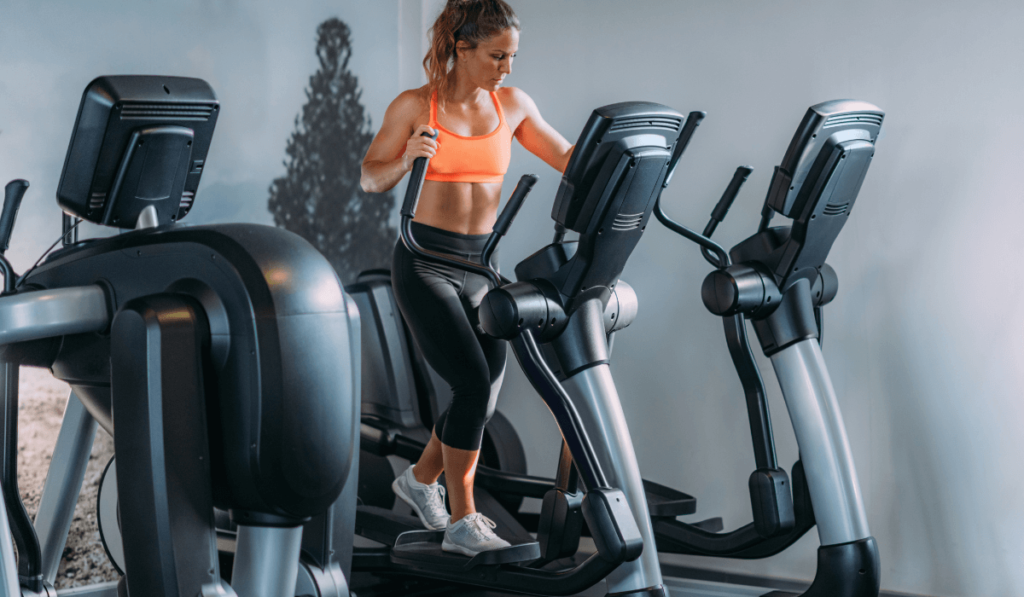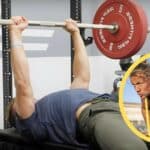There are various good reasons why most running books and training programs mention cross-training for runners. Even though runners love racking up miles, to get the most out of their running, be stronger and avoid injuries, cross training and mixing up their workouts by running on elliptical is a great idea.
There’s only so many miles you can run at any given time. However, mixing up your training sessions can help you chase down endorphins every day without straining the same muscle groups over and over again.
Jump to:
What Is Cross-Training?

Cross-training contains a mix of alternative exercises that can help you become stronger and boost your endurance. For runners, some great examples of cross-training are riding a bike, doing yoga, lifting weights, climbing and even playing soccer.
When cross-training, you use your muscles and whole body in different ways. When running, you’re doing the same motions over and over again, engaging your abs, legs and arms in the exact same ways. Cross-training is a great way to switch things up.
For instance, riding a bike works your glutes, calves, quads, and hips differently from running. Consequently, when biking, you strengthen certain minor muscles that might not be that targeted when running, and you target the big muscle groups in new and more challenging ways.
Is Running on Elliptical an Effective Cross-Training?
There are several reasons why runners cross-train. Some like to cross-train for injury prevention. For instance, runners who have a higher injury risk may choose to run outdoors 3 days a week and cross-train 2–3 days a week. Some runners cross train to boost their training volume by working out twice a day. Others cross-train to maintain their fitness level while healing from an injury or feeling burnt out from running.
Running on elliptical is an excellent form of aerobic training and can be found in most gyms. What’s more, elliptical motion mimics running motion, which makes it a highly effective form of cross-training for runners.
How Can Running on an Elliptical Be Used for Cross-Training?

Aim for 90 Revolutions Per Minute (RPM)
Stride length and stride rate (cadence) are the two factors that determine running speed. The average runner takes 170-185 steps per minute. People running on elliptical for cross-training purposes should strive to mimic their usual cadence. If you are using the elliptical machine, aim for an RPM of 85-90. It may take some practice to do this. For the first few minutes, keep a moderate resistance (2-8) until you feel comfortable with a higher cadence.
When you first start using the elliptical, be patient with yourself. At first, new exercise modes will feel challenging and as you try to figure out the right rhythm on the machine for you, you might have a harder time hitting a higher RPM. It is important to not give up after your first session and to keep practicing. With time, it will become more natural.
Vary the Resistance
The 30-hour workout shouldn’t be spent at maximum resistance, but you shouldn’t plod along at zero resistance. Your goal should be to find the ideal resistance that mimics the motion patterns and intensity of running as closely as possible.
Make sure the resistance is similar to the effort you put in when you run outside. Based on the kind of training you are doing, the resistance will vary. Lower the resistance on the elliptical for an easy “run.” To do an interval workout, maintain 90-95 PRM and then increase the incline for the “on” intervals.
If you want to mimic a tempo run, run a moderately steep incline at a moderately hard intensity and with 90 reps per minute. To simulate running uphill, vary the levels of resistance after several minutes.
Aim for More Time and Effort Rather Than Pace and Distance
You probably won’t run with the same pace when doing elliptical training as you run outdoors, and that’s okay. Although running on the elliptical has similar physiological effects to running outdoors, it still has different mechanics.
Instead of focusing on distance and pace when running on the elliptical, pay more attention to time and effort. On the elliptical, instead of running 6 miles at 10:00/mile, try to train for 60 minutes at a slower pace. On the elliptical, you can cover a greater distance. Nevertheless, the duration of the workout is more important than the distance passed.
Duration and effort can be guided by the rule of specificity. Half marathoners and marathoners who are looking to maintain their fitness while injured should do longer but easier elliptical workouts. To maintain a specific speed suitable for racing, people who are focused on 5Ks and 10Ks should do shorter interval workouts more often on the elliptical.
Use RPE to Measure Intensity
The elliptical does not provide reliable pace information. So, to measure your pace, you should pay attention to perceived exertion instead. Using a rate of perceived exertion (RPE) scale, you can determine your intensity. A pace of 3-4 out of 10 is a pace you feel you could maintain for a long time. An RPE of 8 is more difficult, similar to an interval run.
Maintain Proper Form
Running on elliptical with improper form can be very uncomfortable and have negative effects on your body. It is important to maintain a tall posture while running on an elliptical, as you might experience neck or shoulder pain if you slouch over the bars. You should drive your knees up high when striding. Face forward and don’t tuck your chin in. You can use the moving bars of the elliptical to move your arms like you are running.
Should You Use Hand Bars?
Leaning on the elliptical hand bars to keep your balance might contribute to poor posture and decrease the efficacy of your workout. Nevertheless, using the elliptical hand bars can work your upper body muscles. To get a full body workout, push and pull the bars while pumping the legs.
When to Avoid Running on Elliptical
Avoid running on elliptical machines for cross-training purposes if you have a stress fracture. In this case, opt for entirely non-impact forms of cross-training, like pool running and swimming. And even if you don’t suffer any major foot injuries, if elliptical training feels unnatural to you and hurts, just don’t do it. It’s that simple.
How to Run On Elliptical for Cross-Training?

If you’re looking to maintain your running fitness level and spice up your workouts, here are a few elliptical cross-training workouts for runners to give a try. Just like with outdoor running and any other type of workout, try to keep up with the hard-easy principle. For instance, if you do a hard elliptical training on Monday, go with an easier workout on Tuesday and make sure to also have some days off for active recovery.
Tempo Elliptical Run
- An easy effort at a low resistance (1-4) for 10-20 minutes.
- An effort of moderate to moderately hard for 20–30 minutes. Try to maintain 90 RPM while using moderate resistance (5-10)
- Easy effort for 10–20 minutes at low resistance (1-4).
Elliptical Intervals
- Easy effort at low resistance (1-4) for 10 minutes.
- A total of 6-8 sets of 2 minutes each of hard effort/high resistance (10-15), and 2 minutes each of low resistance (1-4).
- Easy effort for 10 minutes at moderate resistance (3-7).
Steady State Rolling Hills
Resistance levels range from 3-10 and change every 1-3 minutes for 45-60 minutes at a moderate effort.















